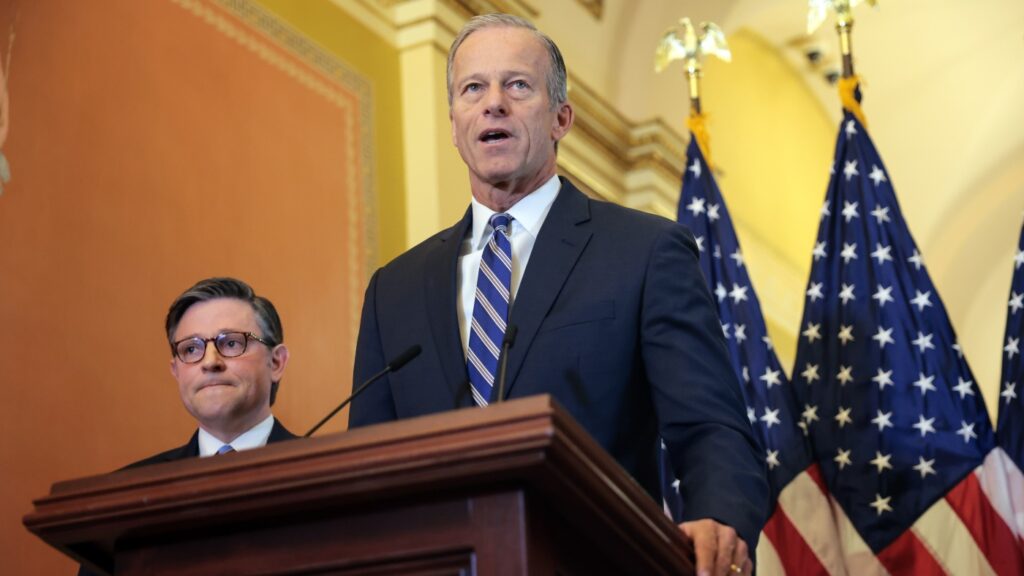
WASHINGTON, DC - APRIL 10: U.S. Senate Majority Leader John Thune (R-SD) (R) and Speaker of the House Mike Johnson (R-LA) hold a press conference on the Republican budget bill at the U.S. Capitol on April 10, 2025 in Washington, DC. The Republican leaders spoke on the reconciliation process and said they would find $1.5 trillion in cuts as the House prepares to vote on President Trump's budget outline for his tax and spending plan after Republican holdouts refused to vote without deeper cuts. (Photo by Kayla Bartkowski/Getty Images)
WASHINGTON D.C. – Senate Republicans unveil updated spending and tax cut bill, aiming for a vote before July 4 deadline.
Senate Republicans have introduced a revised version of their sweeping spending and tax cut legislation, incorporating much of President Trump’s domestic agenda. The bill is set for a vote in the Senate, with Republican leaders pushing to meet their self-imposed deadline of July 4.
The new proposal retains many policies from the House of Representatives’ version passed in May, including extensions of Trump’s 2017 tax cuts and increased funding for border security, defense, and energy production. Republican leaders plan to initiate votes on the legislation by Saturday, with the process potentially extending into Sunday due to an open-ended series of amendments.
Immediate Impact
Where Republicans remain divided is on funding these priorities. Despite similar overarching goals, the Senate’s proposal differs from the House bill with a higher debt limit increase and significant changes to Medicaid.
Notably, the Senate’s version includes modifications recommended by Senate Parliamentarian Elizabeth MacDonough, who identified several provisions that required removal to qualify for a simple majority under reconciliation.
Key Details Emerge
The Senate bill faces opposition from within the party, particularly from fiscal conservatives who aim to reduce the deficit and those opposed to significant cuts to social safety net programs. Internal disputes also persist over the nation’s borrowing limit, with Senator Rand Paul of Kentucky pledging to vote against the bill.
While some GOP Senators express concerns, the more significant challenge may lie in the House, where a narrow majority must concur with the Senate’s version if it passes.
38 members signed a letter to Senate Majority Leader John Thune, criticizing the debt limit increase.
Tax Incentives
The bill incorporates several of President Trump’s tax-related promises. Temporary changes allow Americans to deduct up to $25,000 for tip wages and $12,500 for overtime pay through 2028. These deductions will be reduced for incomes over $150,000, a detail absent in the House version.
The Senate bill also proposes increasing the child tax credit from $2,000 to $2,200 per child, with inflation adjustments post-2025, differing slightly from the House’s temporary increase plan.
Increasing the Debt Ceiling
The Senate suggests a $5 trillion increase in the debt ceiling, surpassing the $4 trillion proposed by the House. Raising the debt limit does not authorize new spending but allows the government to fulfill existing obligations, averting a potential default with global financial repercussions.
The CBO estimates the U.S. will exhaust funds between mid-August and late September without Congressional action.
Industry Response
Changes to SNAP
Both Senate and House bills propose reforms to the Supplemental Nutrition Assistance Program (SNAP), affecting over 40 million low-income Americans. The Senate version expands work requirements for “able-bodied adults” up to age 64, with exemptions for parents of young children and limits on state waivers.
States would also bear a greater share of food assistance costs, based on erroneous payment percentages, effective in 2028.
What’s Stayed Mostly the Same
The Senate bill maintains $4 trillion in tax cuts, slightly exceeding the House’s $3.8 trillion, to extend Trump’s 2017 tax cuts. Without this extension, taxes for most households would rise.
Billions for Border Security
Both bills allocate $46.5 billion for Trump’s border wall, with additional funds for Customs and Border Protection and border security enhancements. The Senate proposes less funding for hiring and retaining agents than the House.
New Immigration Fees
The legislation introduces new or increased fees for immigration services, including a $550 charge for work authorization applications. However, a proposed $1,000 asylum application fee was deemed non-compliant for a simple majority vote by the Senate parliamentarian.
What Comes Next
A Student Loan Overhaul
The Senate plan, like the House bill, seeks to replace existing repayment options with new plans, including a “Repayment Assistance Plan.” It also caps federal loans for parents and graduate students annually.
Differences include the Pell Grant program, where the Senate retains current enrollment rules, unlike the House’s proposed credit hour increase.
Regulating Artificial Intelligence
The Senate allocates $500 million to broadband programs, with stipulations against A.I. regulation for a decade, mirroring the House bill’s stance.
As the GOP megabill progresses through the Senate, its fate remains uncertain amidst internal party divisions and the looming July 4 deadline.






